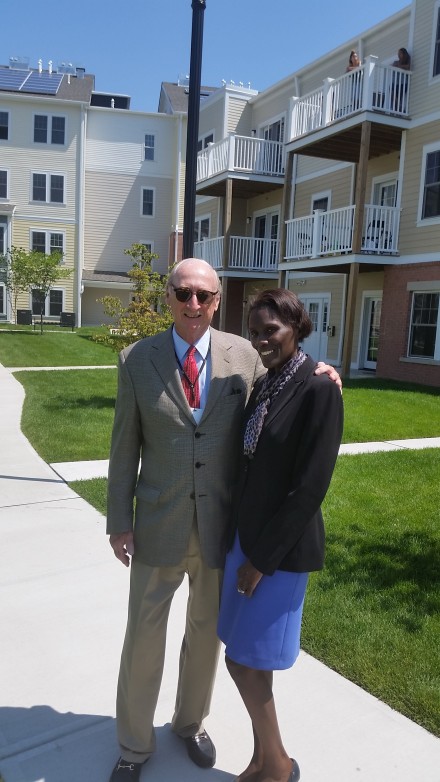
City Councilwoman Mary McBride-Lee remembers when Martin Luther King Drive on the East Side was a war zone of gunfire, drug gangs, crime and grime and despair for public housing residents of the 1,000-unit Father Panik Village, the sanctuary of Waltersville School where she has taught for 35 years beckoning the children of the tenement-style projects. Chief Administrative Officer Kim Staley who lived there as a child recalled its notorious reputation named after the dedicated Catholic priest who lobbied for public housing, but became a symbol of failure long after his death. Tuesday afternoon they both marveled at what is now there, 93 mixed-income townhouses, with 84 more to come, a courtyard of plush green grass welcoming city and state officials at the opening of Crescent Crossings, a $60 million collaboration of the JHM Group and the Richman Group, with assistance from the federal Housing and Urban Development and local housing authority.
Governor Dan Malloy and Mayor Joe Ganim joined about 100 local, state and federal officials and guests for what Malloy termed “a day of celebration” and one of his signature accomplishments, the building of more than 20,000 affordable housing units in the state in his more than six years as governor.
“For a long time,” said the governor, “Connecticut turned its back on quality housing … Quality housing is part of raising people up.”
Ganim, addressing the crowd, said he was “bowled over by its beauty.”
To know what was there decades ago juxtaposed to the modern townhouse-style construction provides a dramatic image.
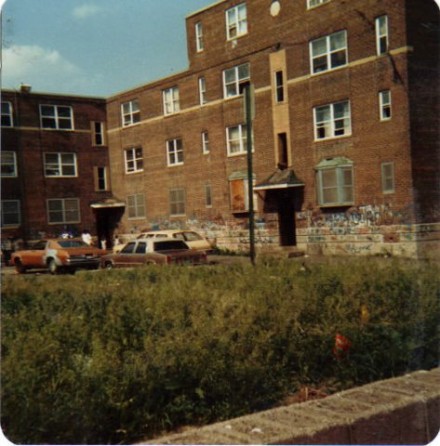
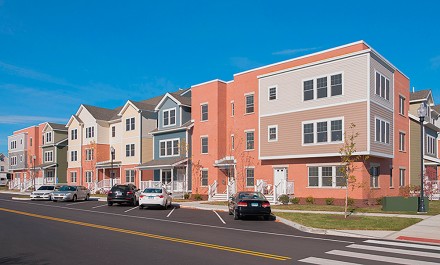
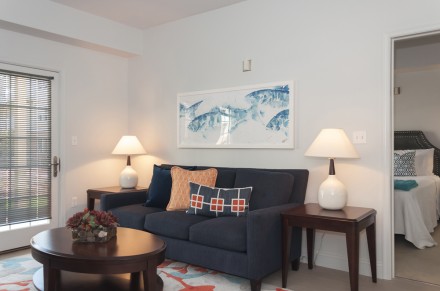
Father Panik Village was constructed in 1939 as the first public housing project in the state, opening under the name Yellow Mill Village. It was renamed in honor of Panik in 1955. Federal landlord neglect and crime increases turned the housing project into a war zone of gun violence. The demolition of Father Panik Village began in the mid 1980s under Mayor Tom Bucci after decades of mayors howling to federal housing officials about the inhumane conditions, crime and impact on public safety. By 1994, in the second term of Joe Ganim’s first tenure as mayor, the last of the 1,000 units came down. Along the way resident relocation efforts challenged the city. Many residents scoffed at the notion of public housing dwellers relocating to their neighborhoods, that often times took on racial tones.

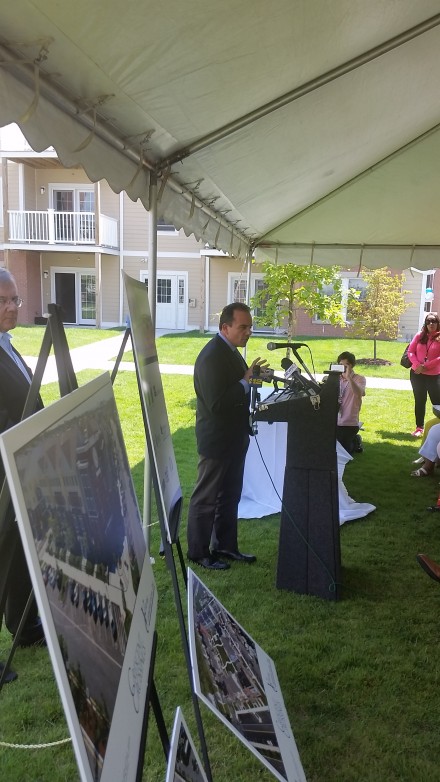

Over the years some housing units went up in the vicinity, but in Crescent Crossings a townhouse village has emerged on the core of the former Panik site, revitalizing a troubled strip.
Building Crescent Crossings, bounded in part by Crescent Avenue and Church Street–a block from the Saints Cyril and Methodius Church–and Martin Luther King Drive, required a complicated financing package that included People’s United Bank and Citibank providing the construction financing. HUD, owner of the property, provided $5 million for flood mitigation.
The project was conceived during the mayoral administration of Bill Finch but a tax deal for a second phase of the project was scuttled by the City Council. On the 2015 campaign trail, Ganim criticized the Finch administration tax arrangement involving the development. Ganim last year announced a financial arrangement with the developer that he asserts is a better deal for the city.
JHM is also involved in replacement units for the troubled Marina Village in the South End where some residents will occupy the new Crescent Crossings. City Councilwoman Denese Taylor-Moye. who represents the South End, declared “I can’t wait until you get to work on Marina.”


Father Panik was the first public housing in the State of CT. There was much community support at the start as WWII began but the course of the large numbers who resided there over the years was not appreciated as the drugs and gun violence took their toll.
Most buildings look handsome at first. Wear and tear occur over time. If maintenance is inadequate or a sometime thing, depreciation is even more rapid.
Public housing may be funded in more imaginative ways than in the past but since taxpayer funds are used and are at risk, the information should be public. And that may be a fiscal tangle with Federal, State, and local inputs. However, to the extent of public participation open, accountable, transparent and honest should be the governance process. Have we gotten there with the newest iteration? Time will tell.
Yellow Mill Village!
Right Grin, it was Yellow Mill Village, my home for 16 years.
93 + 84 = 177 units; divided into $60 million = $339,000 per unit. Wouldn’t it have been cheaper all the way around just to buy people houses in Easton?
yes!
People were put to work. The area will be revitalized. It supports the new train station to be built. Better in Bridgeport than Easton. Besides than you have taxes in Easton and forclosures and etc etc etc.
I wouldn’t hold my breath waiting for the State to cough up $300 million for that second train station less than a mile away from the existing station. The city of Buffalo, NY built a light rail (streetcar) system that serves the whole length of that city for only $269 million.
Imagine having one of these babies running the length of Fairfield and Stratford Avenues, out to Reef Road in Fairfield and Main Street in Stratford, and another line running up Main Street to the Trumbull Mall, connecting everything to Downtown Bridgeport and the train station. Now you’re talking $300 million well spent!
https://www.youtube.com/watch?v=beErfI4I8oo
NIMBY won’t allow that to happen. In a fantasy world it would be cool to see a light rail from Arena all the way to Monroe.
The developer maxes out HUD’s Total Development Cost Limit which is based on unit size in order to maximize their developers fee….then the syndicate the process to pull out the syndication fee. They perform all “property management” while paying no taxes for 20 years. Then the property flips back to ownership of the Housing Authority. Chances of the “property management” company keeping replacement and capital reserve accounts? My prediction, in 20 years, this property will be turned over to the housing authority with no cash and a ton of differed maintenance issues. This was another example of rich Greenwich developers getting their money up front and leaving all the risk to the inner city. Yay!
It is truly attractive and inviting.(No sarcasm here.) But, to put things context, we
should note that this housing is within walking distance of 30,000 living wage jobs — just like the original Father Panik Village. (We should thank Governor Dan Malloy for the great jobs that he has brought to the cities, as well as the housing!… If it weren’t for Dan Malloy and the great state and federal representation and leadership in Hartford and DC, our cities would be in trouble! Thank goodness for their leadership and efforts…) (All aboard! Next stop Stamford!)
Also thank Mayor Finch.
*** From past experience & neighborhood gossip, let’s hope it does not go to shit in about 10yrs. from now. Twin Towers was nice once, so was the apts. on Yarnmish Dr; also many other Bpt. Apt. Dwellings across the city that started nice & new with dreams of better housing for all, be it for seniors or regular folk and in time went to shit. Some managed to stay nice due to the complex rules and nosey neighbors which at times helps keep things in check for the entire complex neighborhood! There are other fairly new or up & coming housing complexes in which in time could sink or swim depending on the tenants , the rent amounts, and over time taxes. One complex I applied to had only 11 fair housing affordable low income apts. available out of a #100 apts. new complex building. Nice and new and affordable to those making at least $75,000. & up a year. Anything less than $75,000. a year and your back in the good old “hood” ! The city council is agreeing to a lousy 10% low income fair market proposal on these new housing complex which leaves the lower income folks out in the cold in the end. Back to the hood, just from one side of town to the other for the poor working folk, no? ***
Mojo we fixed Washington Park 17 years ago for a lot less money and it had remained a revitalized example of success- for a fraction of the $ spent here
Regardless of price, who lives at Wash. Park Bob? There’s also other fairly new housing sites in Bpt. That have gone to shit in a short time. Re-constructed Old Schools around Bpt. , new senior & dissability apts. built; also new lofts and apts downtown that are over priced with limited vehicle parking. If they can’t get enough sales then they rent more apts and lower their standards to make money and at times their rent prices or section-8 tenants, etc. You can build the new Twin Towers, but if it’s in the hood, you may think twice about buying an over priced apt. there, no? ***
Washington Park is low income housing, Mojo
As I have mentioned before, the original mission statement of the authorization for ‘Yellow Mill Village’ was to “provide clean, affordable housing for the workers of Bridgeport’. Workers?
What happened? White flight. LBJ’s ‘The Great Society’.
Remember Beardsley Terrace? High-rise buildings were replaced by (yep) townhouses now known as ‘Trumbull Gardens’.
Will a so-called ‘mixed-income’ housing project fair differently? Why would it?
Please forgive all the duplication of my comment, I don’t know if it’s my computer? Sorry!
My head is spinning right now…I almost want to cry!!!…The list of disasters in Bpt. goes on. I’m not even going to list them because everyone knows them. They all look beautiful when they are built but they all turn to shit. They don’t own them so they don’t care. what follows next, Crime..Drugs…abandon cars,garbage,broken windowsetc etc,,,,,I really hope not, but history says it will….
*** The neighborhood Wash. Park is in has gone to shit, aswell as many of the apts. At Wash. Park have been ransacked by low life tenants. Any new or old low income housing in Bpt. Over time will go to shit especially if it’s located in a bad neighborhood. Time for wonderful dreams of fair low income housing in the city of Bpt. have come & gone. It’s back to the reality of the hood being what it is reguardless of the new buildings and fresh coats of paint on the old! High taxes, high utilities & food, no jobs, drugs & crime along with a failing public school system all help in keeping the dreams of a better life in the hood, feel like nothing more than a passing nightmare! ***
Mojo in Washington Park there are 38 apartments of low income housing occupied by a stable population on thirteen historic mansions that are beautiful and well maintained and the stabilization of its population has rejuvenated the Park.
I was the president and director when we took 13 vacantly and burned properties and restored them.
There are many other successful projects but the City could have done a lot more through the years